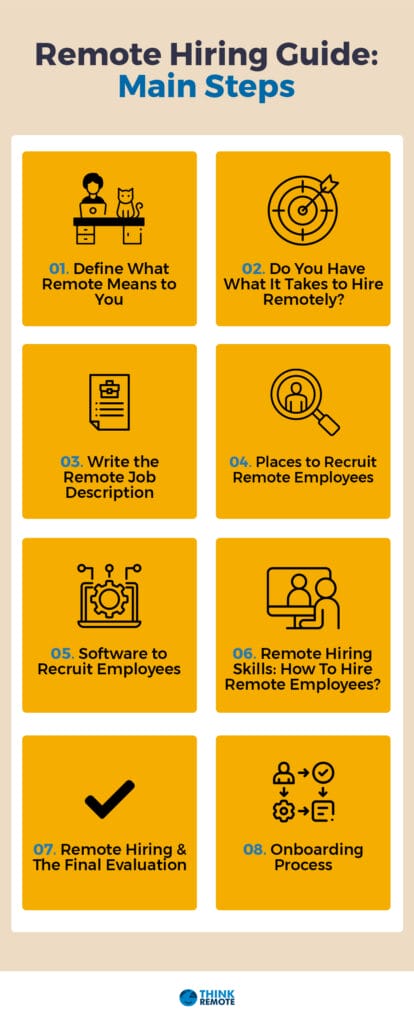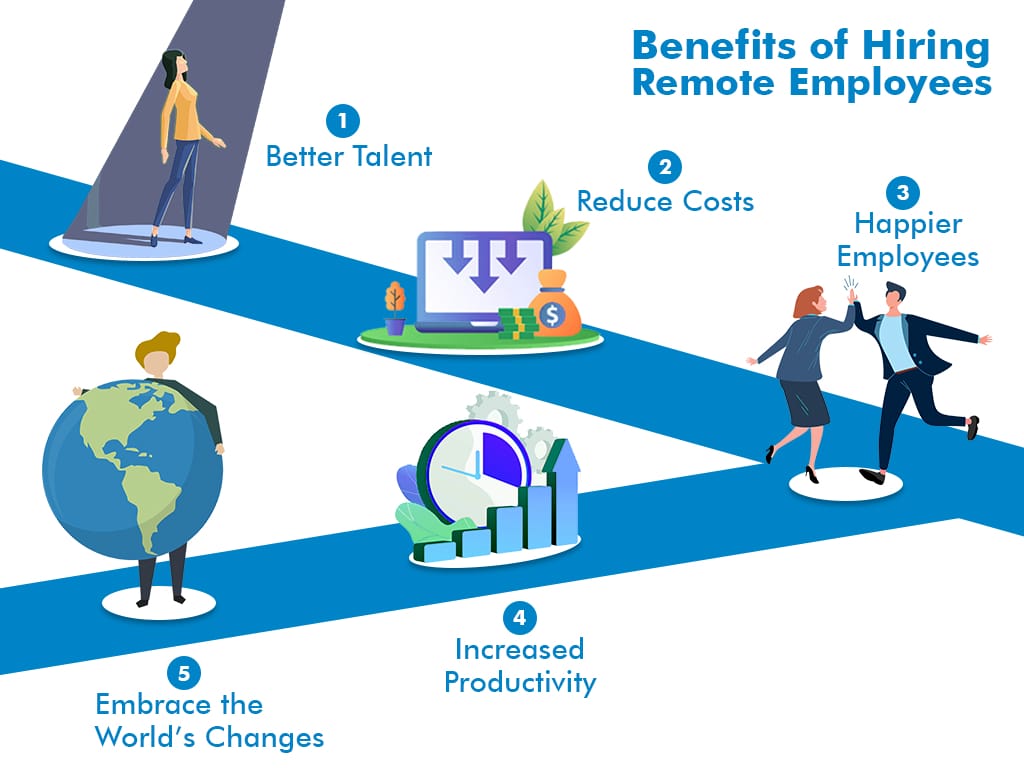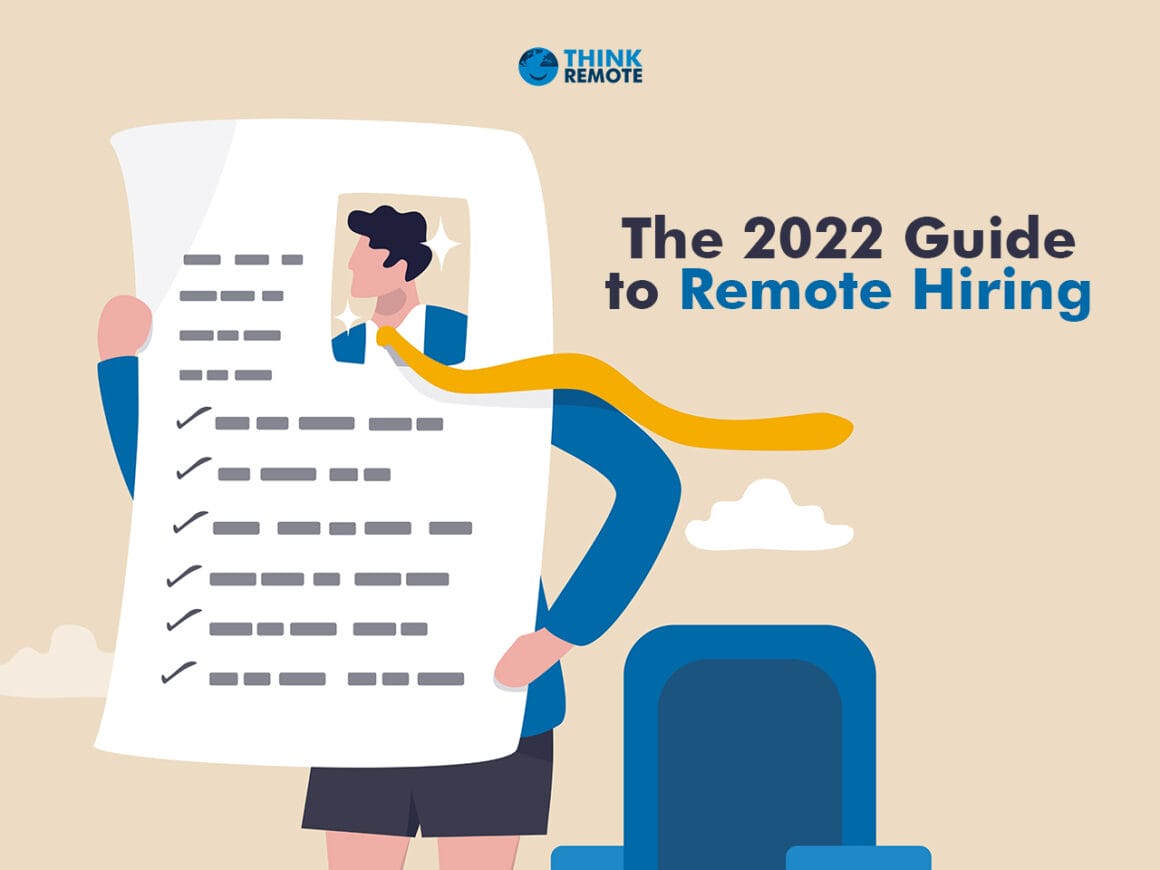As time passes by, the need for remote hiring has become vital for most businesses. Before the pandemic, fully remote companies were relatively uncommon and remote workers were a minority. If you said you worked from home, you were a few of the lucky ones – like a Fruit Loop in a bowl of Cheerios.
Nowadays, companies have realized that having a remote workforce is no longer about surviving the pandemic but it’s also about thriving in a world that is continually changing.
You’ve probably seen by now the vast quantity of companies that decided to go all-in for remote work. Big names such as Spotify, Twitter, Square, Atlassian, and Salesforce (among many others) have announced their working from home new policies.
The main reason why companies want their employees to work from home, or at least, to have the possibility is that they’ve seen the numbers. They now know (by experience) how providing their employees with flexibility has benefited both employees and employers.
According to Hubstaff’s report, State of Remote Work After the Pandemic, only 15.5% of businesses intend to return to 100% office work. This means that the remaining 84.5% will either stay fully remote or with other flexible work options.
If you’re looking to scale your team with the best remote workers, you’ve come to the right place. In this article, you’ll find the ultimate remote hiring guide with everything you need to know about the process of hiring remote workers.
Table of contents
- Remote Hiring Guide: Main Steps
- Step #1: Define What Remote Means to You
- Step #2: Do You Have What It Takes to Hire Remotely?
- Step #3: Write the Remote Job Description
- Step #4: Places to Recruit Remote Employees
- Step #5: Software to Recruit Employees
- Step #6: Remote Hiring Skills: How To Hire Remote Employees?
- Step #7: Remote Hiring & The Final Evaluation
- Step #8: Onboarding Process
- Remote Hiring Benefits and Ideas for Retention
- How to Hire Remote Employees: 5 Important Interview Questions
- FAQs Section
- Ready to Start Hiring Remotely?
Remote Hiring Guide: Main Steps
The first rule of remote hiring: Forget about replicating the same process you do with on-site hiring.
Hiring remotely is entirely different than hiring on-site employees. Your entire HR team will need to adapt to these new practices to be able to be successful. Here’s a complete guide on how to hire remotely in 2022 with everything you need to know.

Step #1: Define What Remote Means to You
Before starting with the remote hiring process, you need to be clear on how you define ‘remote work.’
Start by answering this question: What type of remote employee arrangement are you looking for? Part-time, full-time, hybrid?
If your company is fully remote, then this is not a crucial step. But if you’re transitioning to remote work or you want to run an experiment, keep in mind how hiring a remote worker will impact your business in the long term.
This will also give you the scope of what type of employee you need. For example, if your team is planning to work remotely one day a week, hiring someone with remote work experience might not be crucial. But if your plan is to scale your team with fully remote employees, then that experience is a must.
Step #2: Do You Have What It Takes to Hire Remotely?
Usually, this question works the other way around; you ask candidates if they have what it takes to work remotely. But it’s equally important to be conscious that you are ready to hire and manage remote workers.
It sounds basic, but before starting to look for candidates, you need to make sure that you have the necessary tools to manage a remote team. There are 4 main areas you need to cover when it comes to managing teams virtually:
1) Communication – How will your team be communicating? Keep in mind the time zones and then decide what tools will be best for either synchronous or asynchronous communication. This includes the best video applications, instant messaging apps, and documentation.
2) Project management – When you manage a remote team one of the challenges is to know how projects are moving forward. You can’t go to your employee’s cubicle to ask them about it, so you need a transparent method to keep track of your projects. Therefore, project management tools such as Basecamp, Trello, Asana, among others, are so valuable; they help you visualize if things are running smoothly or if there are any roadblocks.
3) HR – How is your remote team going to get paid? How will you be managing bonuses, vacation days, non-vacation days, sick days, etc.?
4) Documentation & cloud storage – When working remotely, you always need to keep everything documented. If someone needs a document or other type of relevant information, they have the tool for it instead of asking other team members. Google Office, Dropbox, and OneDrive are great cloud storage tools.
These tools are the most basic for remote work. It depends on the area you specialize in that you will need other types of tools. For example, if your business focuses on sales, you’ll likely need a CRM tool.
Step #3: Write the Remote Job Description
When you have the two previous steps covered, it’s time to write down the job description. Before starting to get excited overloading it with skills and requirements, or information about the organization, keep in mind that the job description is the bait that attracts talented candidates. If you write a boring, long, and wordy job ad, they likely continue looking for another job posting.
Here are some tips that can help you attract the perfect candidates:
Title: Don’t go over the top with titles; a simple and concise title is much better than a title with too many weird words. And be clear that the position is for a remote job in the title as well.
Job description: Here, you need to keep it short and sweet. Be clear about what the job position is about, what is the expected role candidates need to fulfill. What will their daily tasks be about?
Skills and requirements: If you need a candidate with a lot of experience, be clear about it. Or if you are willing to accept candidates with zero experience, this is also the space to do it. Here you can add all the skills and requirements that will make an employee successful in the role.
Company description: Don’t write everything about your company. This tends to be extremely boring, so also try to keep it short. Explain what your company does and appeal to the emotional part by saying a bit about what you believe and stand for.
Position details: If you have certain aspects applicants need to know beforehand, this is the space to add them. For example, if you only work with people under certain time zones, or if the job is not 100% remote, all of those essential details should also be covered in the job description.
Bonus tip: Try keeping your job description between 300-600 words.
Step #4: Places to Recruit Remote Employees
Attracting remote candidates consists of several strategies. Once you crafted your job description, you can start promoting it in different ways. But keep in mind that it’s not only about posting the job ad on platforms, but it’s also a mix of headhunting and recruitment that makes this process effective.
1) Job Boards
Unemployed people, or employees looking for better opportunities, are continually looking for job opportunities on job boards. So, if you are ready to start with the remote hiring process, you need to explore these platforms. In this case, where you are looking for a remote employee, the best thing you can do is promote the job opportunity in a remote job board. These are some of the most popular remote job boards:
- FlexJobs
- WeWorkRemotely
- Remote.co
- Remotive
These are other popular job boards for both remote and non-remote jobs that are worth exploring:
- Indeed
- Glassdoor
- CareerBuilder
- Monster
2) Recruit via Social Media
Most recruiters use LinkedIn as the first option to recruit and headhunt candidates. There are some positions that are harder than others to fill, so sometimes you need to bring up your best game and start headhunting candidates. Some of them might already have great jobs, but your ‘royal flush’ here is that you’re offering the opportunity to work remotely, which is a game-changer for many.
This process, however, takes time, you need to screen people you think might be right for the job. You need an HR team that has the capabilities of taking these tasks and performing them efficiently.
Other social media options that are not so popular but still used for some recruiters are Facebook and Twitter.
3) Recruitment Agencies
If promoting and headhunting sounds like too much, you can always ask the help of the experts. Recruitment agencies have been playing this game for many years now, and they know what works and what doesn’t, so if you don’t have the time to select and find the right candidates, you can let them do the job for you.
With the remote work boom, there are recognized remote recruitment agencies that specialize in finding the right remote talent for your company. These are some of them:
- DistantJob
- Robert Half
- Remotetalent.co
- Professional Alternatives
Step #5: Software to Recruit Employees
To save time and energy, you should always have a screening process. Applicant Tracking Systems (ATS) are a great way to screen candidates that might be a great fit from those who directly shouldn’t have even applied to the job.
ATS can handle recruitment and hiring needs by collecting and sorting resumes. They provide the full panorama of the applicants you receive because they compare remote work on resumes with the job descriptions. Therefore, instead of reviewing each application, you can focus on the ones the ATS has identified as a great match.
These are some of the most popular ATS used by companies:
- Taleo
- Workday
- Greenhouse
- BambooHR
- SmartRecruiters
ATS are usually used by big companies that tend to receive thousands of applicants. But if you’re a small company or startup, it might not be necessary for you to install an ATS. However, it’s recommended to have a screening process to help you identify certain aspects of a CV as non-negotiable.
Step #6: Remote Hiring Skills: How To Hire Remote Employees?
As well as remote employees for remote work, you’ll need to have certain skills for remote hiring. The screening and interviewing process is different from the face-to-face hiring process. Here are some skills that will help you sharpen your remote recruitment process.
- Video Interviewing:
Practice video calling. While it sounds like “no big deal” not everyone is confident on a video call. Besides, as a remote recruiter, you need to also be able to read a candidate’s facial expressions on a video call.
Here’s how to go about a remote interview process:
- Provide all the information a candidate needs in the interview invitation you send via email.
- Set up your interview in a quiet space that’s devoid of distractions.
- Double check your webcam, earphones, internet connection and other related tech before starting the video interview.
- Instead of bombarding your candidate with questions right from the start, it’s best to make them feel at ease by starting a casual conversation. This also helps you to know them a little better.
- Asking the right interview questions:
While the position-related and culture-related questions are unique to each organization, when hiring remotely, you also want to know a lot more about whether the candidate is the right choice for a remote position or not. This means, asking questions that will help you gauge their usefulness in a remote setting are important.
Here’s what you can ask to evaluate the candidate for a remote position:
- To test if the candidate can work remotely on their own: What did you do when your manager was absent and you had to make a decision?
- To test personal motivation: What steps have you taken within the last year to improve yourself?
- To test collaborative skills: If you have a problem and can’t find the solution, what do you do? How do you reach out to your colleagues for help?
- To test time management: How do you prioritize tasks and schedule your day?
Step #7: Remote Hiring & The Final Evaluation
It’s time to make the final decision. You have had the interviews and have discussed them with other team members and/or leadership members, so it’s time for you to answer this question: Who’s your best bet?
It often happens that you have a hunch on a particular candidate, maybe because they are Pink Floyd fans as you are or because they love cats. But keep in mind that the unconscious bias we all have sometimes plays a bad game, so try to be as objective as possible.
When making this final evaluation, it’s always helpful to review the notes you took after the interviews and decide which of those candidates has the characteristics and skills you want and need for your team.
During this stage of the process, you’ll have the respective follow-up with the candidate who will start working with you, but it’s always recommended that you also let all the other candidates know that, unfortunately, they didn’t get the job.
Step #8: Onboarding Process
Remote employee onboarding is a crucial step. It’s where new hires experience what it’s like to work for your company. This means they get to understand what your company’s culture is like, as well as your beliefs, goals, and values.
During this time, the idea is to show the employee the virtual office. This means the tools you use and how you use them.
You should also introduce them to the rest of the team and set up clear expectations regarding their role.
To make your job easier and the process smoother, there are many amazing onboarding software that you could get. Here are some of them:
- Monday.com (for collaborative onboarding)
- Sapling (for mid-sized companies)
- ClearCompany (for bulk onboarding)
Remote Hiring Benefits and Ideas for Retention
Remote hiring directly impacts the way your team works and gives you the perfect scenario to build a diverse and inclusive company.

Benefits of Hiring Remote Employees
- Better Talent
Hiring remote employees automatically gives you access to the world’s top talent. When you only focus on local candidates, your hiring process is more frustrating because of the limited options you have.
Maybe you’re lucky to find the exact type of candidate you need fast enough, but what happens when you don’t? You keep insisting on finding a talented candidate to later realize that you’ll eventually need to conform with the least bad one because otherwise, you’ll have that vacancy empty forever.
With remote candidates; you get to see all your options and choose the best one, significantly benefiting your company.
- Reduced Costs
One of the most attractive reasons business owners opt to hire remote workers is to save a lot of money. In a standard on-site setting, hiring employees not only means having to pay their salaries. Other side costs include the physical office space, supplies, snacks, coffee, water, electricity bills, and other essential payments that increase the total amount you spent. But what if you could save all that money?
Companies that hire employees that work from home reduce expenses up to $11,000 per employee annually!
- Happier Employees
Years ago, productivity was measured by the times spent in an office. If your manager saw you typing non-stop in your cubicle, they were satisfied that you were working, and that was enough for them.
Nowadays, the tables have turned, and productivity is no longer measured by time but by the quality of work you do. The output is what matters, which is one of the main reasons why remote work is a huge success.
Remote employees are happier because they are less stressed and work in their own zone. And statistically speaking, according to research, remote workers have a better work/life balance. The less time they spend in the office, the more progress they say they make.
- Increased Productivity
Remote workers get to choose the environment that works out best for them. They can be quiet in their own home office, or they rather go to a coffee shop nearby with excellent Wi-Fi. Either case, it lets them be conscious of what type of environment works best for them.
According to a FlexJobs survey, 95% of the respondents say their productivity increased or remained the same while working from home. And 51% reported being more productive while working from home.
- Embrace the World’s Changes
Remote hiring equals embracing the world’s changes. If one thing covid-19 taught us was to expect the unexpected. Literally, who would have thought that a pandemic was going to happen, and most companies would have to close their doors and work from home?
The world is moving at a fast pace, and employees are no longer only seeking a good salary. They want more quality time to spend with their loved ones and want to achieve a good work-life balance. So, offering these types of benefits instantly makes you an attractive option for them. You get great talent, and they get an amazing job. It’s a win-win!
Everything sounds like rainbows and butterflies, but how to attract, hire and retain those talented remote candidates everyone talks about?
How to Hire Remote Employees: 5 Important Interview Questions
Along with technical and field-related questions, when hiring for a remote position, you also need to ensure that the candidate is comfortable working in a remote environment and has the necessary tools and mindset to be able to do so. Here are some important interview questions to hire remote employees.
Have You Worked Remotely In The Past?
While it’s okay to hire someone who is a newbie to remote work, the question still helps compare better. Someone who has worked remotely in the past knows what’s needed to be able to make it work. From the right devices to knowing that it’s not all “rainbows and butterflies” or rather “pyjamas and naps”, someone even with a little bit of remote work experience knows the real deal.
Where Exactly Do You Work?
You’re trying to figure out where the candidate intends to work physically. Maybe they have their own home office or do they like to work in a coffee shop? This question will help you understand whether or not the candidate has a distraction-free workspace with a stable internet connection.
If they don’t have these facilities, it will help you under what will you need to provide as a company to help your future employee work better.
What According To You Is The Best Way To Complete Projects While Working Remotely?
This interview question will reveal how a candidate approaches a project when they are unable to work together in person. Maybe they like to ask a lot of questions right away.
Perhaps they communicate with their boss and coworkers at every stage of the process to ensure that everyone is on the same page. Or perhaps they have a special talent for controlling timeline expectations. Their responses will reveal their communication style and attitude to difficult projects, as well as the type of collaborator they are.
What Do You Do To Maintain Your Focus While Working?
With remote work, distractions are unavoidable. Pay attention to how a candidate manages various types of interruptions. Some require coping strategies such as sound-canceling headphones to block out everything around them while others are capable of focusing at their workstation despite all the distractions. Ascertain that applicants have procedures in place to assist them in remaining productive and producing their best work.
Which Benefit of a Remote Work Is The Most Valuable For You?
This will help you understand the “why” behind the candidate’s choice to work remotely. Are they choosing it only so that they can work from their bed or just take their job not too seriously? Or are they taking it up because it helps them maintain a good work-life balance and more flexibility in terms of working schedules and hours?
Knowing the candidate’s intention to work remotely will help you understand their mindset and attitude.
FAQs Section
Yes, because remote hiring is a tech-driven process by definition, and recruitment technology (when used wisely) makes the hiring process more efficient.
You could expect a significant rise in applications for remote employment as people from all over the globe apply, even if the majority of them are unqualified. As a result, setting up automated screening processes, including skill assessments, is critical.
Yes, but only if you have systems in place to successfully screen and shortlist individuals. Remote recruiting allows your company access to an enormously wider talent pool and, as a result, a greater number of high-quality candidates than a company that solely recruits from its immediate vicinity.
You can hire remotely all by yourself but know that it is a time consuming process and differs from in-person hiring methods. From screening to interviews and pre-hiring tests, everything is different.
If you don’t have enough knowledge and time, it’s best to hire a boutique remote recruitment agency to avoid making the wrong remote hiring decisions. This will also ensure a smooth hiring and onboarding process.
Ready to Start Hiring Remotely?
The key to successful remote hiring is preparation. If you want to succeed and hire talented remote workers that fit perfectly into your company and culture, you need a solid process. And this remote hiring guide gives you a brushstroke of the fundamental steps to keep into account when selecting, interviewing, and evaluating possible candidates.
Once you’ve taken them, and you have more experience with the remote work world and remote hiring, you’ll be able to adjust them better to your company’s needs.






